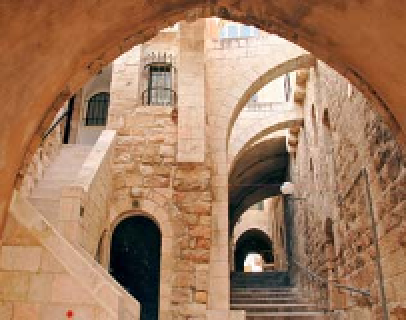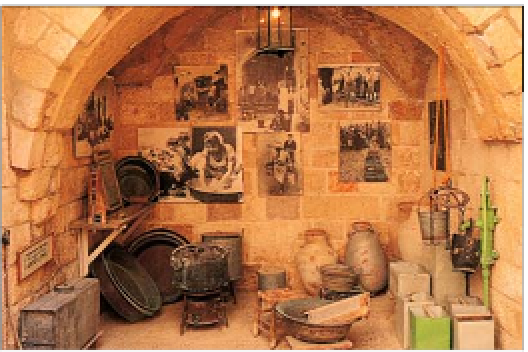Travel Reference
In-Depth Information
Ariel Centre
for Jerusalem in
the First Temple
Period
q
Bonei Hahomah Street.
Map
4 D4.
Tel
(02) 628 6288.
#
9am-4pm
Sun-Thu (Jul & Aug 9am-6pm
Sun-Thu, 9am-1pm Fri).
&
www
.ybz.org.il
The principal exhibit here
is a model of all the archaeo-
logical remains of First Temple
Period Jerusalem (around the
8th century BC). It illustrates
the relationship between
remains, which can be difficult
to interpret when they are seen
on the ground surrounded by
other buildings. It also shows
the original topography of the
area before valleys were filled
in and occupation layers built
up. An audiovisual show
describes the city's history
from 1000 to 586 BC.
There is also a display of
finds from a secret dig carried
out in 1909-11 by English
archaeologist Captain Mont-
ague Parker. His team of
excavators penetrated under-
neath the Haram esh-Sharif
in search of a chamber that
reputedly contained King
Solomon's treasure. When
news of the dig got out,
violent demonstrations by
Jews and Muslims, united
in their opposition to the
desecration of their holy site,
forced Parker to flee the city.
Household objects on display at the Old Yishuv Court Museum
18th-century Or ha-Khayim
Synagogue, used by Ashkenazi
Jews in the 19th century.
Closed between 1948 and
1967, it is now a functioning
synagogue once more.
the heads of Israelite and
Babylonian arrows, as well
as evidence of burning. These
finds are thought to date from
the Babylonian conquest of
Jerusalem in 586 BC
(see p42)
and may identify the gate as
the one through which
Babylonian troops entered the
city (Jeremiah 39: 3). The other
visible remains belong to the
2nd-century BC Hasmonean
city wall, another section of
which can be seen at the
Citadel
(see pp102-5).
The apartment block above
was built on stilts, as were
other modern buildings in the
Jewish Quarter, to allow access
by archaeologists. However,
the need to rebuild rapidly
after the 1948 War meant that
there was insufficient time to
uncover many of the remains
and draw a complete plan
of the area's fortifications.
Israelite Tower
0
Shonei Halakhot Street.
Map
4 D4.
#
9am-5pm Sun-Thu, 9am-1pm
Fri.
&
Steps at the corner of Shonei
Halakhot and Plugat ha-Kotel
streets lead underneath a
modern apartment block to
the remains of a tower of the
7th century BC. The tower,
the walls of which are over
4 m (13 ft) thick and survive
to a height of 8 m (26 ft), is
believed to have been part of
a gateway in the Israelite city
wall. At its foot were found
JEWISH QUARTER ARCHITECTURE
Heavily damaged during the 1948 War,
the Jewish Quarter has been almost totally
reconstructed in recent times. While there is
no distinct “Jewish style”, the quarter's mod-
ern architecture belongs to a well-defined
Jerusalem tradition. First and foremost,
everything is constructed of the pale local
stone. Use of this stone has been mandatory
in Jerusalem since a law to this effect was
passed by the British military governor,
Ronald Storrs, in 1917. Buildings and street
patterns are deliberately asymmetrical to
evoke haphazard historical development.
Streets are also narrow and cobbled, with
many small courtyards and external stair-
cases to upper levels. Buildings make great
use of traditional Middle Eastern elements
such as arches, domes and oriels (the high
bay windows supported on brackets, much
favoured by Mameluke builders). A jumble of
Modern additions harmonise with traditional styles
different heights means that the roof of one
building is often the terrace of another. The
result is a very contemporary look, which is
at the same time firmly rooted in the past.













